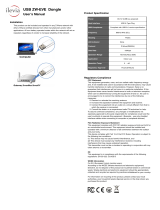
3
TABLE OF CONTENTS
Chapter 1 – SocketModem
®
Cell (MTSMC-G2) & SocketModem
®
iCell (MTSMC-G2-IP)...........................................4
Introduction ..............................................................................................................................................................4
Product Build Options and Ordering Information.................................................................................................4
AT Commands Reference Guides...........................................................................................................................4
Technical Specifications .........................................................................................................................................5
Electrical Characteristics ........................................................................................................................................6
Power Consumption ................................................................................................................................................6
Mechanical Drawings – Basic Build .......................................................................................................................7
Mechanical Drawings – Voice Build .......................................................................................................................8
Mechanical Drawings – IP Build..............................................................................................................................9
Application Notes...................................................................................................................................................10
Flashing LED Interface ......................................................................................................................................10
RF Performances................................................................................................................................................10
RF Connection and Antenna.............................................................................................................................10
Microphone Inputs .............................................................................................................................................10
Changing the Quad Band ......................................................................................................................................11
Chapter 2 – The Antenna System...............................................................................................................................12
Antenna System for Embedded GSM Modems....................................................................................................12
RF Specifications...................................................................................................................................................12
Antenna...................................................................................................................................................................12
Chapter 3 – Design Considerations ...........................................................................................................................13
Noise Suppression Design Considerations.........................................................................................................13
PC Board Layout Guidelines.................................................................................................................................13
Electromagnetic Interference (EMI) Considerations...........................................................................................13
Electrostatic Discharge Control............................................................................................................................14
Chapter 4 – Safety Notices and Warnings .................................................................................................................15
Telecom Safety Warning....................................................................................................................................15
Wireless Safety...................................................................................................................................................15
Upgrading Firmware ..............................................................................................................................................16
Account Activation for Wireless Devices.............................................................................................................16
Wireless Approvals and Labeling Requirements................................................................................................17
Wireless Approvals (GSM, CDMA)....................................................................................................................17
Regulatory Compliance Statements.....................................................................................................................19
Waste Electrical and Electronic Equipment Statement ..................................................................................22
Restriction of the Use of Hazardous Substances (RoHS)...............................................................................23
Information on HS/TS Substances according to Chinese Standards in English..........................................24
Information on HS/TS Substances According to Chinese Standards in Chinese........................................25
Chapter 5 – SocketModem Developer Board.............................................................................................................26
SocketModem Developer Board ...........................................................................................................................26
Board Components............................................................................................................................................27
Jumpers and Corresponding Signals...............................................................................................................27
SocketModem Developer Board Block Diagram .............................................................................................28
Developer Board Schematics............................................................................................................................29
Developer Board Schematics............................................................................................................................30
Developer Board Schematics............................................................................................................................32
Developer Board Schematics............................................................................................................................33





















